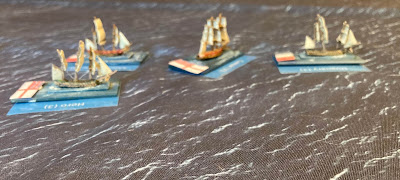The setup for this game, including the ships involved, can be found here. This is my first major game in this genre, so apologies for the lack of nautical terminology.
The Wind in their Sails
British fleet started with the initiative, and Strachan decided to close the gap between the two fleets as rapidly as possible. With the wind in their sails, the British squadron made rapid pace towards the French fleet, although the Caesar at the fore of the British Line came under heavy fire and took substantial damage.Cutting the Line
Dumanoir Strikes Back
By turn four, it looked like a British victory was assured, especially as the Namur had now come into the sight of the main action. However, the French were not defeated. A lucky broadside from the Formidable found its mark felling the Caesar's main sail, which collapsed onto the poop deck, injuring Strachen and the Caesars' senior officers. Strachan was forced to transfer the flag to Captain Gardner on the Hero.This success against Caesar boosted French resolve, and the Formidable now managed to turn back onto the main action. The plucky Scipion, which would prove to have the bravest crew on the day, continued to fight on regardless despite coming under heavy bombardment from the Hero and the Courageux. Finally, the two remaining French ships joined, enabling them to provide mutual support to each other.
The Weather Gods
The advantage was now with the British, and it looked likely that the reenactment would create the historical outcome. Again, when victory seemed inevitable, nature intervened. The wind turned more to the south, and on the next turn, the waters became choppy. It appeared that the infamous lousy weather of the Bay of Biscay would have the last laugh because the conditions gave the French the chance to escape the clutches of the British warships. However, this proved to be a false hope. Another bombardment from the British ships forced the brave Scipion to strike its colours. Finally, the Namur and the Courageux caught up with the French flagship, forcing Admiral Dumanoir le Pelley to surrender.
Some Thoughts
- A test to break the line. It is, from my reading that this was a tricky manoeuvre.
- Introduce a call by the admiral to allow the ships to fight individually. At what point in the game should you introduce ship cards/chits for individual ships and then squadron cards removed?








